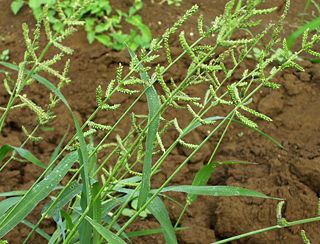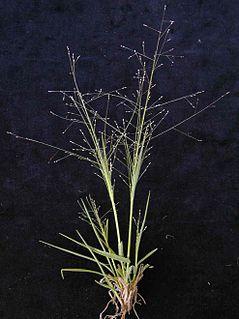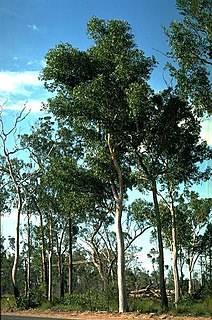
Millets are a group of highly variable small-seeded grasses, widely grown around the world as cereal crops or grains for fodder and human food.

Panicum miliaceum is a grain crop with many common names including proso millet, broomcorn millet, common millet, hog millet, Kashfi millet, red millet, and white millet. Archeological evidence suggests that the crop was first domesticated before 10,000 BCE in Northern China. The crop is extensively cultivated in China, India, Nepal, Russia, Ukraine, Belarus, the Middle East, Turkey, Romania, and the United States, where about half a million acres are grown each year. The crop is notable both for its extremely short lifespan, with some varieties producing grain only 60 days after planting, and its low water requirements, producing grain more efficiently per unit of moisture than any other grain species tested. The name "proso millet" comes from the pan-Slavic general and generic name for millet. Proso millet is a relative of foxtail millet, pearl millet, maize, and sorghum within the grass subfamily Panicoideae. While all of these crops use C4 photosynthesis, the others all employ the NADP-ME as their primary carbon shuttle pathway, while the primary C4 carbon shuttle in proso millet is the NAD-ME pathway.

Panicum virgatum, commonly known as switchgrass, is a perennial warm season bunchgrass native to North America, where it occurs naturally from 55°N latitude in Canada southwards into the United States and Mexico. Switchgrass is one of the dominant species of the central North American tallgrass prairie and can be found in remnant prairies, in native grass pastures, and naturalized along roadsides. It is used primarily for soil conservation, forage production, game cover, as an ornamental grass, in phytoremediation projects, fiber, electricity, heat production, for biosequestration of atmospheric carbon dioxide, and more recently as a biomass crop for ethanol and butanol.

Panicum (panicgrass) is a large genus of about 450 species of grasses native throughout the tropical regions of the world, with a few species extending into the northern temperate zone. They are often large, annual or perennial grasses, growing to 1–3 m tall.

Echinochloa colona, commonly known as jungle rice, deccan grass, or awnless barnyard grass, is a type of wild grass originating from tropical Asia. It was formerly classified as a species of Panicum. It is the wild ancestor of the cultivated cereal crop Echinochloa frumentacea, sawa millet. Some taxonomists treat the two taxa as one species, in which case the domesticated forms may also be referred to as E. colona.
Panicum mosaic virus (PMV) is a positive-sense single-stranded RNA viral pathogen that infects plant species in the panicoid tribe of the grass family, Poaceae. The pathogen was first identified in Kansas in 1953 and most commonly causes disease on select cultivars of turf grass, switchgrass, and millet. The disease most commonly associated with the panicum mosaic virus pathogen is St. Augustine Decline Syndrome, which infects species of turf grass and causes chlorotic mottling. In addition to St. Augustine Decline, panicum mosaic virus is responsible for chlorotic streaking and mild green mosaicking in select cultivars of switchgrass and millet.

Panicum turgidum is an old world clumping desert bunchgrass of the genus Panicum. It is a plant of arid regions across Africa and Asia, and has been introduced to other parts of the world.
Harmonia hallii is a species of flowering plant in the aster family known by the common names Hall's harmonia and Hall's madia.

Panicum hirticaule is a species of grass known by the common names Mexican panicgrass and roughstalked witchgrass.

Andropogon hallii is a sod-forming perennial species in the grass family, Poaceae. It is a bunchgrass which grows in tufts and can reach 7 feet in height under favorable conditions.

Panicum effusum, commonly known as hairy panic, is a grass native to inland Australia. It occurs in every mainland state, as well as New Guinea. In dry conditions, the fast-growing grass can become a tumbleweed.

Tetracoccus hallii is a species of flowering shrub in the family Picrodendraceae, known by the common names Hall's shrubby-spurge and Hall's tetracoccus.

Schoenoplectiella hallii is a species of flowering plant in the sedge family known by the common name Hall's bulrush. It is native to the United States, where it has a disjunct distribution, occurring in widely spaced locations throughout the Midwest and East. It is a rare plant.

Cnaphalocrocis trapezalis is a species of moth of the family Crambidae described by Achille Guenée in 1854. It can be found from Africa to the Pacific region, including Australia as well as in the Dominican Republic, Mexico and Peru.
Galium hallii is a species of plants in the family Rubiaceae. It is known only from southern California:.

Eucalyptus hallii, commonly known as Goodwood gum, is a species of small to medium-sized tree that is endemic to Queensland. It has smooth bark, lance-shaped to curved adult leaves, flower buds in groups of seven, white flower and conical fruit.

Panicum hillmanii, commonly known as Hillmann's panicgrass, is a grass from genus Panicum native to Southwestern United States. It has been introduced to many other areas, notably including southern Australia where it became widespread, and several parts of Europe.
Anaerobutyricum hallii is an anaerobic bacterium that lives inside the human digestive system.












